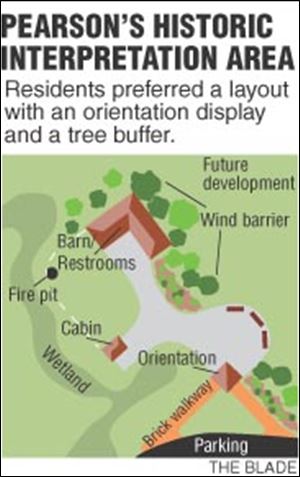
Pearson park expansion proposals coalesce around 1867 log cabin
6/27/2007
Plans for the northern half of Pearson Metropark are starting to move from paper to reality.
A 140-year-old log cabin is to be the centerpiece of its upcoming historic interpretation and preservation area near Seaman and Wynn roads.
Residents also have settled on a layout for the northern half of the park, which encompasses 306 acres of land that Metroparks acquired north of Starr Avenue in 2002.
The 1867 cabin is intact. It was donated by Woodville resident Fred Johlin. Work is being done to restore it to its original, rustic look, said Russ Schifferly, Toledo Area Metroparks' project manager.
The first 27,000 of 58,000 trees for the site's forested wetland project were planted in early April. The remaining 31,000 will be planted in late fall.
The improvements are part of the park's latest management plan, which was discussed with the park district's board of commissioners at a workshop last week at Pearson's Packer-Hammersmith Center.
Jim Speck, the park district's planning director, called the planning document "the foundation for everything that we are going to do in the future."
"It was important that the plan we came up with reflected the values of the community. I think this is a very good reflection of what the community wanted to see," he said, acknowledging contributions area residents made to it with their comments.
Eighty percent of Pearson North will be a forested wetland reminiscent of the Great Black Swamp era. A large, passive recreation area will be incorporated into the site to enhance public use.
Residents had five development options for the interpretive area. They chose one with an orientation kiosk through which two brick walkways pass en route to the historical section, Mr. Schifferly said.
One path will lead to the cabin. The other will lead to a restored barn connected to modern restrooms.
A wind barrier of trees will help give the illusion that visitors have traveled back in time to the 1860s.
Residents wanted an historic barn to help educate the public about farming during the Great Black Swamp era, Mr. Schifferly said.
"Evidently people felt that having a barn is representative of the Great Black Swamp experience," he said.
The plan is to be reviewed by Metroparks staffers before it's carried out.
The northern half of Pearson nearly doubled the park's size to 626 acres. The Metroparks put $1.23 million toward the $2.05 million purchase price, with the remainder coming from a grant of $820,000 from the Clean Ohio Fund.
Like other parts of northwest Ohio, the northern half of Pearson was drained and tiled years ago so that it could be used as a farm. The Ohio Wetlands Foundation of Columbus is helping the park district restore it into its natural wetlands state.
So far, the Friends of Pearson group has raised $225,000 of its $400,000 goal. The group also has provided in-kind service.
Plans for the rest of the acreage include an expanded picnic area, new parking areas for people who want to use the trail system, more trails, mounding around the picnic areas, and tree buffers around the perimeter of the park.
Contact Erika Ray at eray@theblade.com
or 419-724-6088.